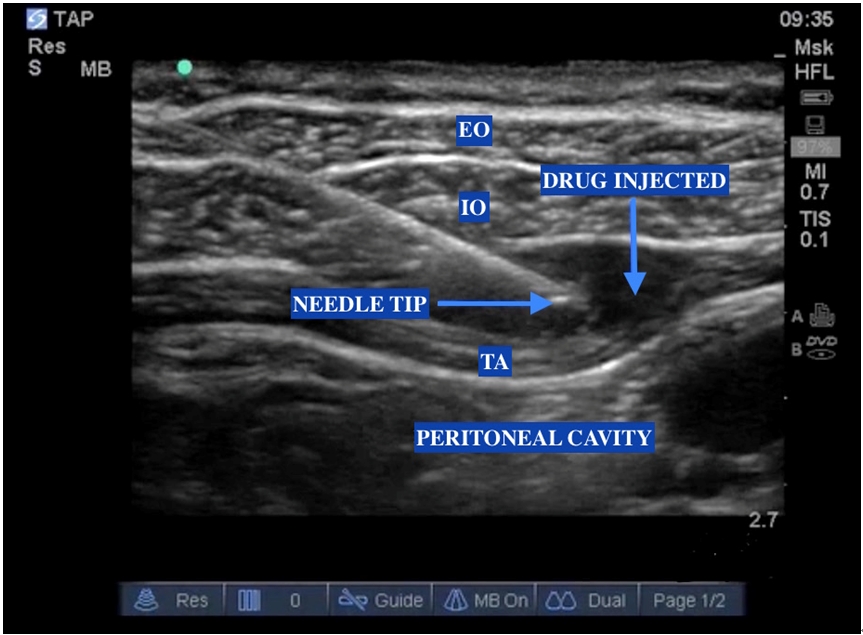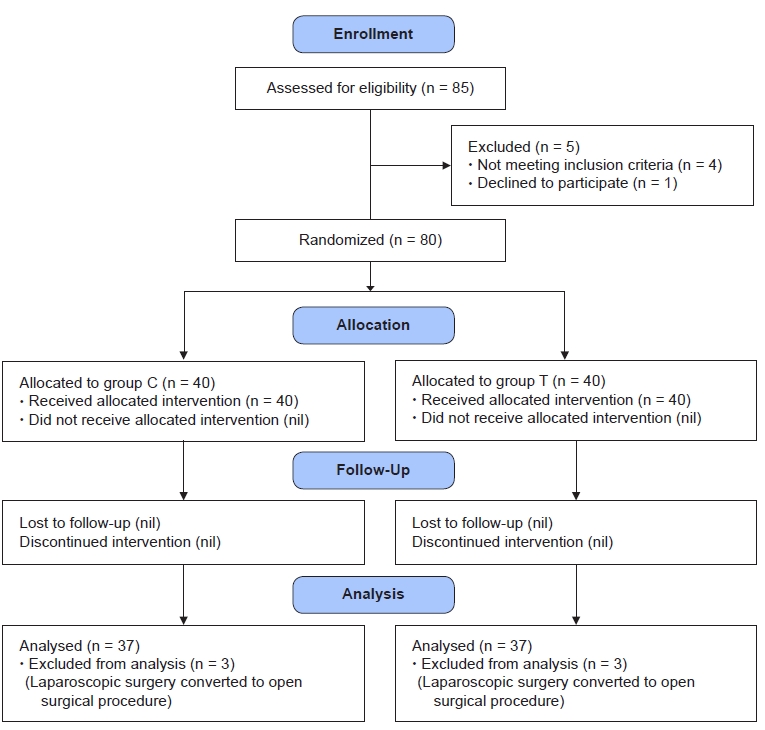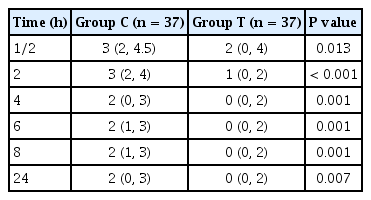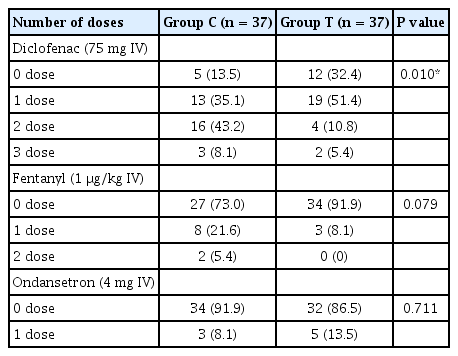Analgesic efficacy of ultrasound-guided transversus abdominis plane block for laparoscopic gynecological surgery: a randomized controlled trial
Article information
Abstract
Background
This study aimed to determine whether ultrasound-guided transversus abdominis plane (TAP) block is more effective in reducing postoperative pain and analgesic consumption than local anesthetic infiltration (LAI) at the port site for elective laparoscopic gynecological surgeries.
Methods
Eighty patients with the American Society of Anesthesiologists status I/II undergoing laparoscopic gynecology surgery were enrolled for this randomized control trial. After general anesthesia was administered, patients in group C received LAI at each port site, and patients in group T received bilateral ultrasound-guided TAP block. Postoperative pain was assessed at time intervals of 1/2, 2, 4, 6, 8, and 24 h using the numeric rating scale (NRS). Clinical metrics such as postoperative analgesic diclofenac consumption, need for rescue fentanyl, nausea-vomiting scores, and antiemetic requirements were also recorded.
Results
Seventy-four patients were included in the final analysis. Postoperatively, patients in group T had significantly lower NRS than those in group C (P < 0.05). The highest difference in the postoperative NRS was observed at 2 h (median [1Q, 3Q]; group C = 3 [2, 4]; group T = 1 [0, 2]; P < 0.001). A statistically significant difference was observed in the frequency of diclofenac (75 mg intravenous) requirement between the groups (P = 0.010). No significant difference was observed between the groups in need of rescue fentanyl or antiemetic and the nausea-vomiting scores.
Conclusions
In patients undergoing laparoscopic gynecological surgery, ultrasound-guided TAP block provided greater postoperative analgesic benefits in terms of lower NRS and reduced analgesic requirements than port site LAI.
INTRODUCTION
Although laparoscopic gynecological surgery is less invasive than open gynecological surgery, significant postoperative pain remains possible. Trocar insertion, tissue dissection, and the creation of pneumoperitoneum contribute to postoperative pain in laparoscopic surgery [1,2]. Undertreatment of this pain can lead to patient discomfort, nausea, vomiting, and consequently delay the patient's recovery and discharge. Commonly, local anesthetic infiltration (LAI), intraperitoneal instillation of local anesthetic, or neuraxial anesthesia are used along with systemic drugs such as opioids, non-steroidal anti-inflammatory drugs (NSAIDs), and dexamethasone for the treatment of postoperative pain from laparoscopic surgery [3,4].
The ultrasound-guided transversus abdominis plane (TAP) block is simple to perform and has recently become a popular technique for reducing postoperative pain after abdominal surgery. It has been shown to provide effective postoperative analgesia in a variety of open abdominal surgical procedures with an opioid-sparing effect and allowing faster patient recovery [5–8]. For laparoscopic surgery, the TAP block has been found to be effective in reducing postoperative pain at rest and opioid consumption. A dose-response relationship was also observed between the local anesthetic dose used in the TAP block and its effect on late pain at rest and opioid consumption [9].
While studies have been conducted to evaluate TAP block in laparoscopic hysterectomy, only a few studies have assessed its benefit in laparoscopic gynecological surgeries [10,11]. Therefore we planned the present study to evaluate whether ultrasound-guided TAP block provided any postoperative analgesic benefits over LAI in patients undergoing laparoscopic gynecological surgery. Our study was based on the hypothesis that ultrasound-guided TAP block is more effective in reducing postoperative pain and analgesic consumption than LAI at the port insertion site in elective gynecologic laparoscopic surgeries under general anesthesia. We considered postoperative pain score at 2 h as an indicator of early post-surgical pain and discomfort. Therefore, the primary outcome of the study was postoperative numeric rating scale (NRS) at 2 h. Postoperative NRS at 1/2, 4, 6, 8, and 24 h, postoperative analgesic requirement (diclofenac), need for rescue analgesia (fentanyl), postoperative nausea and vomiting (PONV) scores, and requirement of antiemetics were the secondary outcomes measured in the first 24 h after surgery.
MATERIALS AND METHODS
This prospective randomized control study was conducted at a tertiary care teaching institute after approval from the Institutional Ethics Committee. Ethics committee approval was received for this study from the ethics committee of Employees’ Insurance Cooperation Postgraduate Institute of Medical Sciences and Research (no. DM(A)H-9/14/17–2012 PGIMSR). This study was registered at Central Trial Registry India (CTRI/2018/05/013625). Eighty patients with the American Society of Anesthesiologists status I/II in the age group of 18–60 years undergoing elective laparoscopic gynecologic surgery excluding laparoscopic hysterectomy were enrolled in this prospective randomized trial from February 2017 to February 2018. Patients with obesity (body mass index > 30 kg/m2), hypersensitivity to amide local anesthetics, steroids, anticoagulant treatment, or with bleeding disorders were excluded from the study. The principal investigator enrolled all patients for the study after a thorough pre-anesthetic check, and written informed consent was obtained. The patients were randomized to group C (general anesthesia with LAI) or group T (general anesthesia with TAP block) using a computer-generated random numbers list, and the allotment was concealed using sealed envelopes. All procedures involving human participants were performed in accordance with the ethical standards of the institutional and/or national research committee and with the 1964 Helsinki Declaration and its later amendments or comparable ethical standards.
On the day of surgery, the sealed envelope containing the group allotment was handed over to the anesthesia consultant in the operation theater. All patients received oral alprazolam 0.25 mg on the night before and on the morning of surgery. After shifting to the operation theater, all monitors including electrocardiogram, pulse oximetry, and non-invasive blood pressure were attached to each patient, and a Ringers’ lactate drip was started. General anesthesia was induced with fentanyl 2 μg/kg intravenous (IV), propofol 2–3 mg/kg IV, vecuronium 0.1 mg/kg IV, and after adequate muscle relaxation, an appropriately sized pro-seal laryngeal mask airway was inserted. Anesthesia was maintained with 50% O2, 50% N2O, and 1–2% sevoflurane and positive pressure ventilation to maintain an end-tidal carbon dioxide concentration of 30–40 mmHg.
Laparoscopic surgeries were performed by insertion of four ports, one at the level of the umbilicus and three at the infra-umbilical level. Patients in group C were given LAI at the port insertion sites before trochar insertion at the start of surgery; a 20 ml syringe of 0.25% levobupivacaine was drawn up and 5 ml of the local anesthetic was infiltrated at each port site. Patients in group T received bilateral ultrasound-guided mid-axillary TAP block with 20 ml of 0.25% levobupivacaine on each side before the start of surgery. After cleaning the skin with 2% chlorhexidine solution, a high frequency 6–13 MHz linear ultrasound transducer probe (Sonosite, USA) was placed at the level of the mid-axillary line between the 12 ribs and the iliac crest. The three abdominal wall muscle layers, external oblique, internal oblique (IO), and transversus abdominus (TA) were visualized. A 10 cm long 22-gauge TAP block needle (SonoTAP, Pajunk, Germany) was inserted until the needle tip reached the plane between the IO and TA (Fig. 1). The correct placement of the needle tip in the TAP block plane was confirmed by visualizing the separation of the fascial plane between the IO and TA on the injection of a small volume (up to 5 ml) of saline. Thereafter, 20 ml of 0.25% levobupivacaine was injected, and the spread of the drug in the TAP block plane was seen as an elliptical hypoechoic shadow (Fig. 2).

Sonographic image showing insertion of sonotap needle with the needle tip reaching the plain between IO and TA muscles. EO: external oblique, IO: internal oblique, TA: transversus abdominis, TAP: transversus abdominis plane.

Sonographic image showing spread of local anesthetic drug in the transversus abdominis plane (TAP) block plane and the separation of the fascial plane between IO and TA muscles. EO: external oblique, IO: internal oblique, TA: transversus abdominis.
During the surgery, the patient's hemodynamic parameters including heart rate, systolic blood pressure (BP), diastolic BP, and mean BP were recorded at five minutes interval. Additional IV dose of fentanyl 1ug/kg was administered if there was a 15% increase in hemodynamic parameters from baseline, and the total requirement of fentanyl during surgery was recorded. After completion of the surgery, inhalation anesthetic agents were turned off, the neuromuscular blockade was reversed, and the patient was extubated.
The patients were transferred to the recovery room where they were assessed for pain by another anesthesiologist who was blinded to the group allocation. Pain was assessed on 11 points per NRS (0, no pain; 10, worst imaginable) at 1/2, 2, 4, 6, 8, and 24 h. The postoperative analgesic regimen comprised diclofenac 75 mg intravenously for NRS ≥ 3. For acute pain (NRS > 5), IV dose of fentanyl 1ug/kg was administered as rescue analgesia. No additional analgesic medications were administered to the patients. The total diclofenac consumption and need for rescue analgesia (fentanyl) in the 24 h postoperative period was recorded. PONV was assessed on the categorical scale: 0, none (no nausea or vomiting); 1, mild (nausea only); 2, moderate (nausea with retching); 3, severe (nausea with vomiting); ondansetron 4 mg IV was administered for PONV score > 2. The next day, the site of the TAP block was inspected for swelling, infection, or hematoma before discharge from the hospital.
Based on the pilot cases in patients receiving general anesthesia with LAI (group C), the highest anticipated NRS for patients at 2 h in the postoperative period was 5 (SD = 2.5). We considered a 40% (i.e. 2 points on NRS score) reduction in NRS scores to be of clinical relevance. With a type I error of 0.05, and a type II error of 0.10, a sample size estimated was 33 patients per group with an effect size of 0.80 to detect a significant difference in NRS scores. We recruited 80 patients to allow for any dropouts and exclusions. Details of the recruitment of patients are shown in the Consolidated Standards for Reporting of Trials (CONSORT) flow diagram for the study (Fig. 3), the demographic profile and surgical characteristics of patients in the two groups are shown in Table 1.
Statistical analyses were performed using the SPSS program for Windows (version 17.0, SPSS Inc., USA). Data were checked for normality prior to the statistical analyses. Continuous variables are presented as mean ± SD or median (1Q, 3Q), categorical variables are presented as absolute numbers and percentages. Normally distributed continuous variables including age, weight, intraoperative fentanyl dose, surgical and anesthesia times, total 24 h diclofenac requirement were compared using independent Student’s t-test. Non-normally distributed continuous variables, including postoperative NRS and PONV scores, were analyzed using the Mann–Whitney U test. Categorical variables including the American Society of Anesthesiologists status, number of patients needing additional intraoperative fentanyl, frequency of requirement of postoperative analgesics, and antiemetic were compared using the Fisher’s exact test. Statistical significance was set at P < 0.05.
RESULTS
Of the 80 patients enrolled in the study, six were excluded from the final analysis due to the conversion of the laparoscopic procedure to open surgery by the surgeon (Fig. 3). Patients in groups C and T had comparable demographic and surgical characteristics (Table 1). Table 2 shows the postoperative NRS (primary outcome) for the two groups, these were significantly lower in group T than in group C at 1/2, 2, 4, 6, 8, and 24 h. The highest difference in the postoperative NRS was observed at 2 h (median [1Q, 3Q]; group C = 3 [2, 4]; group T = 1 [0, 2]; P < 0.001).
The mean total fentanyl requirement during surgery for patients in two groups was statistically comparable (mean ± SD; group C = 105.0 ± 21.2 μg, group T = 112.2 ± 23.9 μg; P = 0.177) (Table 1). Four patients in group C and five in group T needed additional fentanyl 1 μg/kg during surgery after the induction dose of fentanyl 2 μg/kg (P value >0.999). The requirement of analgesics and antiemetics for patients in groups C and T in the 24 h postoperative period is shown in Table 3. A statistically significant difference was observed in the requirement of diclofenac (75 mg IV) between groups C and T (P = 0.010). Postoperatively, 32 patients (86.5%) in group C and 25 patients in group T (67.6%) required diclofenac medication for analgesia. The highest number of patients (16/37, 43.2%) in group C required two doses of diclofenac; the majority in group T (19/37, 51.4%) required only one dose of diclofenac for pain relief. The total diclofenac requirement over the 24 h postoperative period was also significantly lower in group T (68.6 ± 63.4 mg) than in group C (113.5 ± 61.0 mg; P = 0.003). No statistical difference was observed in the requirement of rescue fentanyl or ondansetron between the groups.
The PONV scores were statistically comparable at all points of time in the postoperative period for patients in both groups (median [1Q, 3Q]; group C = 0 [0, 1], group T = 0 [0, 1]; P value >0.999). None of the patients had swelling, hematoma, or infection at any site of the abdominal wall on follow-up on the first postoperative day.
DISCUSSION
The study showed that ultrasound-guided TAP block significantly lowered the postoperative NRS in patients undergoing laparoscopic gynecological surgery. The reduction in NRS was both statistically and clinically significant as a 2-point difference was seen at 2, 4, 6, 8, and 24 h postoperatively. Furthermore, the patients who received TAP block had lower consumption of analgesics (diclofenac) and rescue analgesia (fentanyl) in the 24 h postoperative period compared to those with a given LAI. However, the TAP block group did not differ from the control group in terms of the PONV scores or antiemetic requirements.
The findings of our study are similar to previous studies of Kawahara et al. [12] and De Oliveira et al. [13] showing the significant analgesic effect of TAP block in laparoscopic gynecology surgery. However, these studies differ in the approach of the TAP block, the local anesthetic used, and the comparator control group. In a study by Kawahara et al. [12], patients undergoing laparoscopic gynecological surgery receiving mid-axillary TAP block with 0.35% ropivacaine (20 ml each side) had significantly reduced postoperative pain, analgesic consumption, and nausea-vomiting compared to patients receiving TAP block with saline. Similarly, De Oliveira et al. [13] found that a posterior TAP block with 0.25% or 0.5% ropivacaine to improve the quality of recovery scores and reduce postoperative pain and opioid consumption in patients undergoing daycare gynecological laparoscopy surgery. Conversely, El Hachem et al. [14] reported no postoperative analgesic benefit of TAP block over trocar site LAI in laparoscopic gynecological surgery. In their study, each patient was given a TAP block on one side and LAI on the other side of the abdomen; thereafter, the postoperative pain on both sides was compared.
The pain associated with laparoscopic gynecological surgery includes visceral pain from manipulation of the uterus, fallopian tube, and vagina, and parietal pain from stretching of the parietal peritoneum by pneumoperitoneum and port insertion in the abdominal wall. Commonly, LAI at the port site or intraperitoneally has been used together with opioids, NSAIDs, dexamethasone, and lidocaine infusion for multimodal analgesia for laparoscopic gynecological surgeries [15,16]. Despite several studies on LAI at port sites or intraperitoneally, the results of its analgesic effect are controversial. While Pellicano et al. [17] and Ceyhan et al. [18] found LAI intra-peritoneally and at the port site reduced the postoperative pain, other researchers demonstrated LAI at the port wound did not result in significant analgesia [19,20]. The meta-analysis by Mark et al. [4] concluded that the analgesic effect of LAI was short-lived and limited only to the early postoperative period (6 h).
In contrast to LAI, the TAP block has been found to provide a longer duration of analgesia, lasting up to 24 h, along with a greater opioid-sparing effect for lower abdominal surgery [21,22]. The spread of the local anesthetic in the plane between the TA and IO muscles and the consequent blockade of the anterior rami of the thoracolumbar nerves (T6 to L1) results in sensory block of the anterolateral abdominal wall and somatic pain relief [23,24]. However, researchers have found that the spread of injectate and its resultant analgesic effect of TAP block may be affected by several factors including patient population type (pregnant or non-pregnant, obese or nonobese), the injected volume of local anesthetic, the technique (blinded or ultrasound guided), and the timing and choice of approach of TAP block (preoperative or postoperative) [6,25,26].
The results of our study can be applied to daycare laparoscopic gynecological procedures. However, for more accurate measurement of pain scores and analgesic consumption, these patients were admitted on the first postoperative day. The limitation of the study was that the pain assessment was limited to 24 h, and we did not evaluate NRS on movement. In addition, this was a single-center study. Recently, dexmedetomidine and fentanyl have been used as additives to local anesthetics in TAP block to improve the quality of postoperative analgesia and enhance patient recovery [27,28]. We would like to plan further studies to elucidate the benefits of these additives on the analgesic efficacy of TAP block in laparoscopic gynecology surgery.
This study demonstrates that ultrasound-guided mid-axillary TAP block is a useful component of multimodal analgesia in patients undergoing laparoscopic gynecological surgery. The TAP block significantly reduced the NRS and analgesic requirements in the 24 h postoperative period compared to the LAI at the port site. However, it did not have any effect on PONV scores or requirement of antiemetics.
Notes
FUNDING
None.
CONFLICTS OF INTEREST
No potential conflict of interest relevant to this article was reported.
DATA AVAILABILITY STATEMENT
The datasets generated during and/or analyzed during the current study are available from the corresponding author on reasonable request.
AUTHOR CONTRIBUTIONS
Conceptualization: Divya Sethi. Data curation: Divya Sethi. Formal analysis: Divya Sethi. Methodology: Divya Sethi, Garima Garg. Project administration: Divya Sethi. Visualization: Divya Sethi. Writing - original draft: Garima Garg. Writing - review & editing: Divya Sethi. Investigation: Divya Sethi, Garima Garg. Resources: Divya Sethi. Software: Divya Sethi, Garima Garg. Supervision: Divya Sethi. Validation: Divya Sethi.




